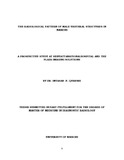| dc.contributor.author | Qureshi, U. Intasab | |
| dc.date.accessioned | 2016-04-27T09:16:45Z | |
| dc.date.available | 2016-04-27T09:16:45Z | |
| dc.date.issued | 2015 | |
| dc.identifier.uri | http://hdl.handle.net/11295/95131 | |
| dc.description.abstract | Urethral stricture is one of the common causes of lower urinary tract
obstruction in Africa. Its impact includes pain, disturbance in family and
social life and complications include renal failure, and urethral carcinoma. The
pattern of causes of urethral stricture are said to be changing with time. Up to
early 1980s, infection especially gonococcal infection was the leading cause of
urethral stricture. With advent of wide spread antibiotic use, changes in life
style and advances in technology, trauma has become the commonest cause.
Objective
The main objective of this study is to determine the radiological pattern of male
urethral strictures among adults at KNH in Nairobi, Kenya.
Methodology
This prospective study was conducted at Kenyatta National Hospital
Department of radiology and the Plaza Imaging Solutions. Participants
included patients sent to the Department of radiology to undergo ascending
urethrography or micturating cystourethrography and presenting with clinical
evidence of urethral strictures.
Findings
Two hundred adult male patients with clinically suspected urethral strictures
were recruited between April and November 2012. The mean age was 45 years
(SD ± 18.2). Out of the 200 patients 138 (69%) had a stricture (average size 2.9
cm ± 1.6). Most patients (52%) had pelvic fractures and 21% of patients had
iatrogenic strictures following instrumentation or catheterization. Other causes
infective causes (10%) or dysuria (17%). Seventy one (35.5%) strictures were
located in the posteriorurethra while 36 (18%) were in the anterior and 31
(15.5%) spanned both the anterior and posterior urethra. Most (61.4%)
strictures occur in single as compared to multiple (38.6%) sites.
ix
Conclusion and discussion
Most urethral strictures in adult males in radiology units at Kenyatta and Plaza
imaging are caused by iatrogenic trauma and accidental pelvic injuries. To
avert cases of urethral strictures there is need to improve techniques for
surgical intervention and clinical skills in managing urologic conditions in
patients | en_US |
| dc.language.iso | en | en_US |
| dc.publisher | University of Nairobi | en_US |
| dc.rights | Attribution-NonCommercial-NoDerivs 3.0 United States | * |
| dc.rights.uri | http://creativecommons.org/licenses/by-nc-nd/3.0/us/ | * |
| dc.subject | The Radiological pattern of Male Urethral strictures in Nairobi | en_US |
| dc.title | The Radiological pattern of Male Urethral strictures in Nairobi | en_US |
| dc.type | Thesis | en_US |
| dc.description.department | a
Department of Psychiatry, University of Nairobi, ; bDepartment of Mental Health, School of Medicine,
Moi University, Eldoret, Kenya | |



